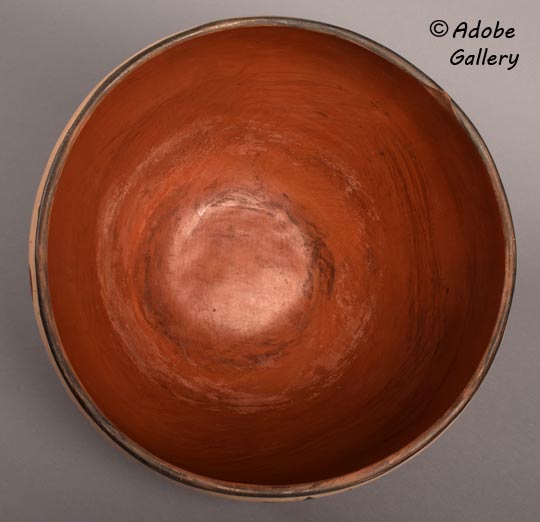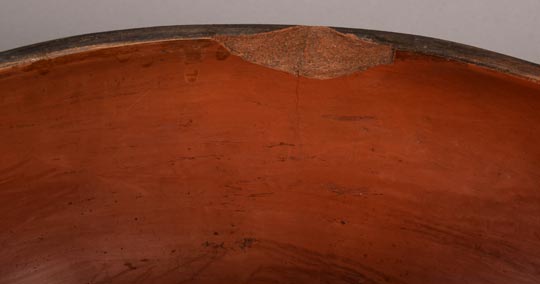Historic Santo Domingo Pueblo Polychrome Dough Bowl with Floral Designs
+ Add to my watchlist Forward to Friend
Forward to Friend
- Category: Historic
- Origin: KEWA, Santo Domingo Pueblo
- Medium: clay, pigment
- Size: 9” deep x 16” diameter
- Item # C4731R
- Price: $6500
This exquisite dough bowl, crafted by an anonymous potter, likely dates back to the 1930s. Its graceful form features a beautifully curved wall that ascends from the base to a gently inward-curving rim. The artist skillfully employed a creamy slip to cover two-thirds of the vessel's surface, creating a canvas for a stunning floral arrangement. The lower portion of the bowl is adorned with a rich red slip, while a striking black rim frames the top of the design. For practical use, the interior of the bowl was stone-polished, likely intended for the preparation of oven bread within the potter's home.
Dough bowls, a testament to the ingenuity of Pueblo people, emerged in response to the introduction of white flour by the Spanish in the late 1600s. However, it wasn't until the mid-1700s that Pueblo communities began to incorporate this new ingredient into their culinary traditions. To accommodate the baking of oven bread, families constructed ingenious beehive-shaped adobe ovens, which are still visible at many Pueblo homes today.
The painted design on this bowl is a captivating rhythmic floral arrangement that gracefully encircles the vessel. Large, vibrant orange flowers and smaller black blossoms are intertwined with black vines and distinctive perforated leaves. Pottery painting, a tradition with roots stretching back 1,500 years, is an integral aspect of Pueblo vessel creation. It is believed that a vessel is not truly complete until it is adorned with a meaningful design.
Painting on a curved surface presents a unique challenge for the artist. Unlike a flat canvas, the potter can only view a small portion of the vessel at a time, requiring a keen sense of spatial awareness and a strong visual memory. The artist must carefully plan and execute the design, envisioning the entire composition while working on a limited section.
Prior to 1880, little is known about Santo Domingo pottery, as production was primarily focused on utilitarian objects for local use. The arrival of a rail spur near the pueblo in the 1880s marked a turning point, as potters began creating smaller items to sell to train travelers. By the early 1900s, Santo Domingo had established a reputation for producing exceptional pottery, a tradition that continues to thrive today.
Condition: very good condition with one rim chip on the interior of the bowl with an adjoining crack (see below).
Provenance: this Historic Santo Domingo Pueblo Polychrome Dough Bowl with Floral Designs is from the collection of a resident of New Mexico
References:
-Verzuh, Valerie. A RIVER APART, The Pottery of Cochiti & Santo Domingo Pueblos
-Batkin, Jonathan. Pottery of the Pueblos of New Mexico 1700-1940
TAGS: Southwest Indian Pottery, Kewa - Santo Domingo Pueblo, Contemporary Pottery, Ceremonial breaks


- Category: Historic
- Origin: KEWA, Santo Domingo Pueblo
- Medium: clay, pigment
- Size: 9” deep x 16” diameter
- Item # C4731R
- Price: $6500
Adobe Gallery Recommended Reading
Adobe Gallery Recommended Items
If you are interested in this item, we would also like to recommend these other related items:



